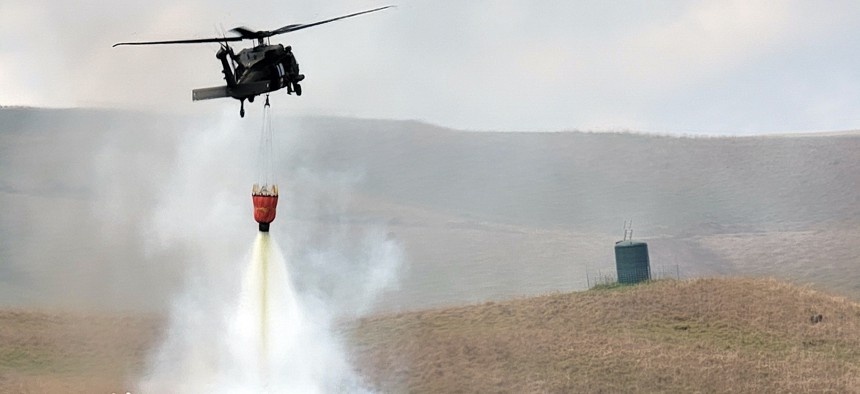
U.S. Army HH-60 Black Hawk pilots and flight crew assigned to Charlie Company, 3rd Battalion, 25th Aviation Regiment, 25th Combat Aviation Brigade, 25th Infantry Division, help local firefighters extinguish a fire using a Bambi bucket near the Pohakuloa Training Area, Hawaii, July 31, 2021. U.S. Army / Capt. Ryan DeBooy
New Defense Department Climate Plan: Adjust Ops, Training, Gear for Extreme Weather
Virtual exercises will help when wildfires rage; equipment will be tested for health effects in intense heat and cold.
From hurricane winds that ravage military bases to monster wildfires that shut down exercises, extreme weather is forcing the military to rapidly shift how it trains and equips, the Defense Department said in its 2021 climate plan Thursday.
“More extreme environments may require changes to where and how U.S. forces train for future conflict,” the Department’s 32-page action plan found, as it laid out how its force, weapons systems and facilities will be able to operate as rising temperatures and sea levels introduce dangerous variables to people, buildings and gear.
In the last year alone, wildfires in California shut down more than a dozen training exercises at Naval Air Weapons Station China Lake because it was too dangerous for personnel and aircraft to operate in the heat and smoke.
To respond, the department is modifying its training and medical skills for the force, bolstering personal protective gear, and when conditions are still prohibitive, acknowledging that “wargaming, enhanced AI-based simulations, and state-of-the-art tabletop exercises may also assist in reducing the risks of actual ground-based maneuvers in extreme conditions.”
It’s also adding climate resilience to its evaluation of new weapons and boosting research on protective gear and systems. Next year’s Arctic Edge 2022 exercise will test weather shelters that could help U.S. forces continue operating when adversaries cannot.
Both existing and future gear will also be examined to see whether their chemicals and materials could harm troops in extreme heat or cold.
“DOD must consider the impacts to readiness and mission that substitution of chemicals with global warming and/or unintended environmental consequences may pose,” the report said. “Removal of key chemicals from the supply chain may necessitate development of costly alternatives.”



